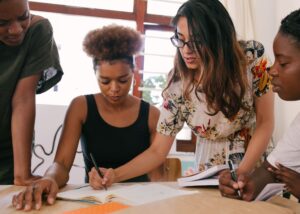We all are waiting for the schools to reopen. It has not only been tough for learners but also for the teachers to conduct classes online during this pandemic. We are still a long way off from the normalcy of pre covid times. We have to make it our way of life.
Shared below are some notes on making social distancing work in your school?
Prepare teachers, staff, parents, and students
All groups need to be prepared for the school reopening post-COVID. These have been unprecedented times, restarting needs understanding of everyone’s frame of mind. A survey with each of the groups on their readiness to restart school will create a framework for future interactions and also sensitize the school on their anxieties.
A representative working group of parents, teachers, and staff should be set up for planning & execution of the new protocols in school. A health and sanitization consultant may also be brought on board.
The group should undergo a risk assessment exercise. These sessions must plan the structure of functioning, classroom arrangement, social distancing, circulars, and policies on COVID guidelines for ensuring safety and hygiene at school.
Teachers are expected to deal with learning recovery and, student’s mental and psychosocial needs. The school counselor must also help the teachers plan the student engagement. Minimize any activity that requires physical contact or sharing of resources. Train teachers to help children understand the social distancing guidelines and how to ensure their safety. This communication must also be planned with parents & students.
The group must identify the spaces that are an absolute must for the functioning of the school. Spaces, where social distancing is difficult to implement, must be kept closed/ alternatives identified.
People Driven Learning

Children gain a lot from being in school, with their interactions with teachers and peers. While technology has served us well to plan learning interactions, we must also leverage it to allow greater physical interactions. We must ensure that this technology is available in all classrooms. Children should be able to attend class discussions from the home virtually or physically in classrooms. The scheduling or the school roster should be managed to allow social distancing between those present in school. Blended classrooms that have been talked about lately gain more relevance to create “personalized learning”.
Designated Zones on Designated Days
Children must have access to as many spaces in the school as possible. A coding mechanism may be implemented to create designated zones for children for various days of the week. This way groups that will go to the spaces will be predesignated. And the sanitization team will be able to clean the spaces after use by each group.
Communicate with Parents
Parents must be assured of their ward’s safety at school. The working group’s recommendations implemented in school must be shared with the parents, they need to be on board for the reopening. They must understand the tasks from them. Unless the parents support this it will be difficult to get children to follow. The processes should be implemented to create a safe space and avoid any fear-based messaging, to be sensitive to all.
While there is awareness of hygiene, safety, and social distancing, implementing it in a school space means that there have to be greater awareness rules at school. The use of masks, sanitizers, and hand wash should be facilitated by their easy access in school. In spite of these measures, there has to be ownership where parents must monitor their children, the children and staff must also self-assess. It is only when there is this acknowledgment can such a system work. The communication then becomes important.
Staggering Hours / Days at School
Staggering hours, the students’ arrival at school can be planned in a way to prevent overlap with the next slot. This will give enough time to implement cleaning protocols and assembly of large groups. Plan transport timings or ask parents to pick and drop their kids to maintain safety. With the time slot, you have to plan the seating arrangements as a measure for social distancing. When technology is leveraged in school then the entire class does not need to be in on the same day.
School Transport
Parents might prefer to drop their children at school on their own. Whenever it is possible to restart school a spaced seating arrangement to maintain social distance must be implemented.
As all children do not attend the class on the same day, the spacing will be possible in school transport. The transports must be sanitized after every use.
Cleaning, disinfection, and sanitization
Cleaning removes impurities from the surfaces while the disinfection process uses chemicals to kill germs that might be present on the surfaces and sanitization works either by cleaning or disinfection and lowers the risk of spreading infection. Timely sanitization at school will help lower the risk of spreading infection.
A variety of sanitization procedures must be implemented as different areas/surfaces may need different procedures.
Maintain Hygiene and Ensure Safety
Wearing masks should be mandatory for everyone on the premises. Everyone should be sensitized on the kind of masks to wear, to wear them properly, and to use fresh masks each day. Everyone should also be encouraged to carry spare masks and to change them in case any gets dirty. Also, they must not share or switch masks.
The school may implement entry protocols for temperature and oxygen saturation, at the same time there must be a safe & comfortable isolation zone for students/staff who show symptoms that warrant isolation/ non-entry to the school.
Use Poster and signages

Use posters and signages to display the safety measures for everyone at school with language and visual medium that is suited to the children. Visual information is more easily grasped.
The goal of the exercise is to restart the learning among the children in a healthy and safe way. Processes often fail because of the human element, getting all stakeholders on board is very important for this to succeed. And all variations must be documented so that there is a clear understanding of the reasons for each failure. These will enhance the ability to prevent them the next time and to improve the processes.



